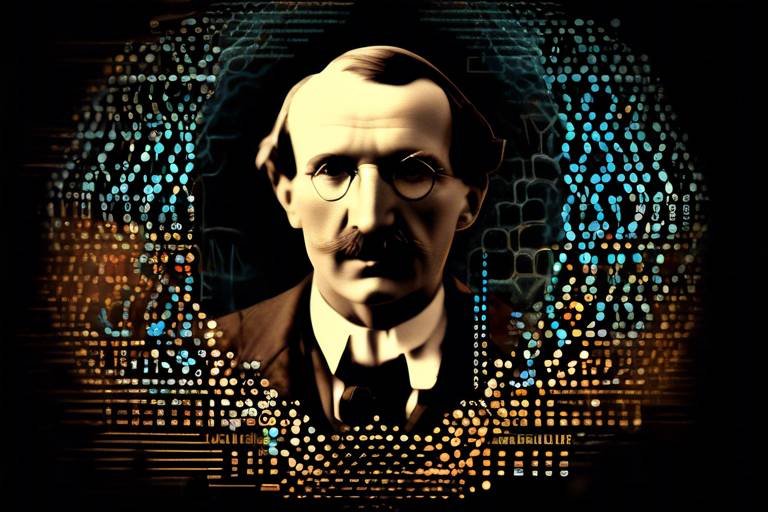Vitruvius: The Architect of Ancient Rome
Vitruvius, the Architect of Ancient Rome, stands as a monumental figure in the history of architecture. His renowned work, Ten Books on Architecture, continues to inspire architects and designers worldwide. Vitruvius's contributions to Roman architecture have left an indelible mark on the field, shaping the architectural landscape of ancient Rome and beyond.
Delving into Vitruvius's early life and education unveils the foundation upon which his architectural legacy was built. His upbringing, steeped in the arts, engineering, and architecture, provided the fertile ground for his future endeavors in design and construction. This formative period played a crucial role in shaping his philosophies and approach to architecture.
Vitruvius's philosophies on architecture emphasize the importance of functionality, beauty, and durability in design. His belief in symmetry and design aesthetics laid the groundwork for his influential theories on proportion and harmony. Through his work, he sought to create structures that not only served practical purposes but also embodied timeless beauty and balance.
The impact of Vitruvius's engineering innovations reverberates through the annals of history. His contributions to engineering practices in ancient Rome, from aqueducts to siege engines, revolutionized construction techniques of the time. His innovative approaches set new standards for structural integrity and efficiency, leaving a lasting imprint on Roman engineering.
As we explore Vitruvius's legacy in modern architecture, we witness the enduring influence of his artistic vision and proportions. His theories on symmetry and balance, exemplified in the iconic Vitruvian Man, continue to inspire artistic representations in architecture. Contemporary architects draw upon his principles to create harmonious and aesthetically pleasing designs that echo the timeless elegance of Vitruvius's work.
Urban planning and infrastructure development also fell under Vitruvius's purview, as he offered insights into city layout, sanitation systems, and public amenities. His holistic approach to creating functional and visually appealing urban environments set a precedent for future city planners and architects. Vitruvius's recommendations continue to inform urban design practices, emphasizing the importance of both practicality and aesthetics in city planning.
The Architectural Treatise, Ten Books on Architecture, remains a cornerstone of architectural history. This seminal work delves into a wide range of topics, from construction techniques to architectural theory, offering invaluable insights into the principles of design. Each book within the treatise serves as a testament to Vitruvius's enduring influence on architectural practice and education.

Ten Books on Architecture.
Vitruvius's Ten Books on Architecture stands as a monumental work that has greatly influenced the field of architecture throughout history. This treatise, composed of ten books, covers a wide range of topics essential to understanding the principles of architectural design and construction in ancient Rome.
In the Ten Books on Architecture, Vitruvius meticulously details various aspects of architecture, ranging from the selection of building materials to the principles of symmetry and proportion. Each book delves into specific areas of architectural practice, providing a comprehensive guide for aspiring architects and builders.
Book I of Vitruvius's treatise focuses on the education and training required for architects, emphasizing the importance of a well-rounded knowledge base in mathematics, geometry, and the arts. This foundational knowledge serves as a basis for understanding the more complex principles discussed in subsequent books.
Book II explores the properties of different building materials, such as stone, wood, and concrete, highlighting their strengths and limitations in construction. Vitruvius's detailed explanations aid in the selection of appropriate materials based on the intended use and structural requirements of a building.
Books III and IV delve into the design and construction of various types of public buildings, including temples, theaters, and basilicas. Vitruvius elucidates the architectural elements essential for creating functional and aesthetically pleasing structures that serve the needs of society.
Book V addresses the principles of town planning and infrastructure development, offering insights into the organization of cities, streets, and public spaces. Vitruvius's recommendations on urban design aim to enhance the quality of life for inhabitants and promote efficient use of resources.
Books VI and VII focus on architectural ornamentation and decorative elements, emphasizing the role of ornament in enhancing the visual appeal of buildings. Vitruvius's discussions on aesthetics and design details provide guidance for creating visually striking architectural compositions.
Books VIII and IX delve into the construction of water-related structures, such as aqueducts, baths, and fountains. Vitruvius's expertise in hydraulic engineering is evident in his detailed explanations of water supply systems and their integration into urban environments.
Finally, Book X of the Ten Books on Architecture addresses the role of the architect in society and the ethical considerations involved in architectural practice. Vitruvius emphasizes the architect's responsibility to uphold moral and ethical standards while contributing to the built environment.

Learn about his contributions to Roman architecture and his enduring legacy in the field of design.
When exploring the life and work of Vitruvius, the renowned architect of ancient Rome, one cannot overlook his significant contributions to Roman architecture and his enduring legacy in the field of design. Vitruvius's impact on the architectural landscape of ancient Rome was profound, shaping the development of structures such as temples, theaters, and public buildings. His architectural theories and designs influenced not only the construction practices of his time but also the future of architectural development.

Early Life and Education
Exploring the life and work of Vitruvius, the renowned architect of ancient Rome who authored the influential Ten Books on Architecture.
Before delving into Vitruvius's architectural achievements, it is essential to understand his early life and education. Born in a time of great cultural and artistic flourishing, Vitruvius was immersed in the world of architecture from a young age. His education was not limited to just the technical aspects of building; he also studied engineering and the arts, developing a well-rounded understanding of design principles.
Imagine a young Vitruvius, eagerly absorbing knowledge like a sponge, drawing inspiration from the world around him. His formative years laid the foundation for his future endeavors in architecture, shaping his unique perspective and approach to design.
As he honed his skills and knowledge, Vitruvius's upbringing instilled in him a deep appreciation for the intersection of functionality and beauty in architectural creations. This early exposure to the art of building would later define his philosophies on architecture and design.

Philosophies on Architecture
Vitruvius's philosophies on architecture were deeply rooted in the fundamental principles of functionality, beauty, and durability. He believed that architecture should not only serve a practical purpose but also embody aesthetic appeal and stand the test of time. Vitruvius emphasized the importance of symmetry and proportion in architectural design, striving to achieve a harmonious balance between form and function.
Central to Vitruvius's architectural philosophy was the idea that buildings should not only be structurally sound but also visually pleasing. He advocated for the use of natural materials and the incorporation of artistic elements to enhance the overall design. Vitruvius's approach to architecture was holistic, considering the interplay between the built environment and the natural world.
In his writings, Vitruvius expounded on the concept of firmitas, utilitas, and venustas, which translate to durability, utility, and beauty. These three principles formed the cornerstone of his architectural philosophy, guiding architects to create structures that were not only sturdy and functional but also aesthetically pleasing.
Vitruvius's philosophies on architecture continue to influence contemporary designers and architects, serving as a timeless source of inspiration for those seeking to create innovative and enduring architectural works. His belief in the importance of balance, harmony, and proportion has transcended centuries, shaping the way we perceive and approach architectural design today.

Influence on Roman Architecture
Vitruvius's influence on Roman architecture was profound and far-reaching, shaping the very fabric of the ancient city. His architectural theories and designs played a significant role in defining the aesthetic and structural elements of Roman buildings, including temples, theaters, and public structures. Vitruvius's emphasis on functionality, beauty, and durability set a standard for Roman architecture that endured for centuries.
One of the key aspects of Vitruvius's influence on Roman architecture was his promotion of symmetry and proportion in building design. By advocating for harmonious and balanced structures, he contributed to the creation of visually striking and architecturally sound buildings that defined the Roman landscape. His principles on architectural aesthetics guided the construction of iconic Roman edifices, reflecting a deep understanding of design principles.
Furthermore, Vitruvius's engineering innovations had a lasting impact on Roman construction practices. His expertise in designing aqueducts, roads, and siege engines revolutionized the way infrastructure projects were approached in ancient Rome. By introducing innovative techniques and methodologies, Vitruvius elevated the standards of engineering excellence in Roman architecture.
The legacy of Vitruvius in Roman architecture can still be seen today in the remnants of ancient structures that have withstood the test of time. His enduring influence on architectural theory and practice continues to inspire architects and designers around the world, showcasing the timelessness of his ideas and the lasting impact of his contributions to the field of architecture.

Engineering Innovations
When it comes to engineering innovations in ancient Rome, Vitruvius stands out as a trailblazer in the field. His contributions span a wide range of disciplines, from the design of aqueducts to the development of advanced siege engines. Vitruvius's innovative approaches not only revolutionized construction practices but also laid the groundwork for future engineering marvels.
One of Vitruvius's most notable achievements was his expertise in aqueduct design. These intricate systems of channels and pipes were essential for supplying water to Roman cities, ensuring a steady and reliable water source for public baths, fountains, and private residences. Vitruvius's meticulous attention to detail and understanding of hydraulic principles were instrumental in the success of these aqueducts, some of which are still in use today.
In addition to his work on aqueducts, Vitruvius also made significant contributions to road construction. The Roman road network, known for its durability and efficiency, was a testament to Vitruvius's engineering prowess. By incorporating proper drainage systems, sturdy foundations, and strategic routing, Vitruvius ensured that these roads could withstand heavy traffic and harsh weather conditions, facilitating efficient transportation throughout the empire.
Furthermore, Vitruvius's expertise extended to the realm of siege engines, formidable weapons used in military campaigns to breach enemy fortifications. His innovative designs and strategic insights revolutionized the field of military engineering, allowing Roman armies to conquer new territories and defend their borders effectively. Vitruvius's contributions in this area not only influenced ancient warfare but also paved the way for future advancements in siege technology.
In conclusion, Vitruvius's engineering innovations were instrumental in shaping the infrastructure of ancient Rome and beyond. His expertise in aqueduct design, road construction, and siege engine development set a high standard for engineering excellence, leaving a lasting legacy that continues to inspire engineers and architects to this day.

Legacy in Modern Architecture
Vitruvius's legacy in modern architecture transcends time, with his principles and ideologies continuing to shape contemporary design practices. Architects and designers worldwide draw inspiration from his timeless philosophies on architecture, symmetry, and aesthetics. His emphasis on the triad of functionality, beauty, and durability remains a cornerstone of architectural theory, guiding the creation of structures that not only serve a purpose but also evoke a sense of beauty and longevity.
One of the most significant aspects of Vitruvius's legacy is his influence on the concept of proportion and harmony in architectural design. His famous depiction of the Vitruvian Man, illustrating the ideal proportions of the human body, has inspired generations of artists and architects. The pursuit of symmetry and balance in architectural compositions can be traced back to Vitruvius's teachings, underscoring the enduring relevance of his artistic vision in modern architectural practice.
Moreover, Vitruvius's insights on urban planning and infrastructure have left a lasting impact on the development of cities and public spaces. His holistic approach to creating functional and aesthetically pleasing urban environments resonates with contemporary urban planners seeking to design sustainable and livable cities. Vitruvius's recommendations for city layout, sanitation systems, and public amenities continue to inform urban development strategies, highlighting the timelessness of his ideas.
As architects navigate the complexities of modern design challenges, they often turn to Vitruvius's architectural treatise, Ten Books on Architecture, for guidance and inspiration. This seminal work remains a foundational text in architectural history, offering valuable insights into the principles of design, construction, and aesthetics. The topics covered in each book of the treatise provide a comprehensive framework for understanding architectural practice, reflecting Vitruvius's comprehensive approach to architecture as a multifaceted discipline.

Artistic Vision and Proportions
When it comes to artistic vision and proportions in architecture, Vitruvius's insights are truly remarkable. His theories on proportion and harmony have left a lasting impact on architectural design, influencing generations of architects and artists. One of the most iconic representations of Vitruvius's ideas is the Vitruvian Man, a drawing that embodies the perfect proportions of the human body within a circle and square.
Vitruvius believed that architecture should not only be functional but also aesthetically pleasing. He emphasized the importance of symmetry and balance in design, striving to create structures that not only serve a purpose but also evoke a sense of beauty and harmony. His meticulous attention to detail and proportions set a standard for architectural excellence that continues to inspire architects to this day.
By incorporating mathematical principles and geometric relationships into his designs, Vitruvius sought to achieve a sense of order and proportion that resonated with viewers on a fundamental level. His belief in the interconnectedness of architecture, mathematics, and nature led to the creation of buildings that not only stood the test of time but also captivated the imagination.
Through his exploration of artistic vision and proportions, Vitruvius elevated architecture to a form of art, where every line, curve, and angle held significance. His legacy continues to shape the way we perceive and create architectural masterpieces, reminding us that great design is not just about function but also about the harmonious balance of form and beauty.

Urban Planning and Infrastructure
Urban planning and infrastructure were paramount in the architectural vision of Vitruvius, reflecting his comprehensive approach to city development. In ancient Rome, Vitruvius emphasized the importance of well-organized urban spaces that catered to both functionality and aesthetics. His insights extended beyond individual buildings to encompass the broader fabric of cities, focusing on creating harmonious environments that promoted the well-being of their inhabitants.
One of Vitruvius's key contributions to urban planning was his advocacy for structured city layouts that optimized the use of space and facilitated efficient movement. He proposed strategic placement of public amenities, such as baths, theaters, and forums, to enhance the quality of urban life. By incorporating elements of symmetry and proportion in city design, Vitruvius sought to create visually pleasing environments that fostered a sense of order and balance.
In addition to architectural considerations, Vitruvius recognized the importance of infrastructure development in sustaining urban centers. He championed the implementation of advanced sanitation systems, including aqueducts and sewage networks, to promote public health and hygiene. By integrating infrastructure with architectural design, Vitruvius aimed to create sustainable cities that could withstand the test of time.
Vitruvius's holistic approach to urban planning and infrastructure set a precedent for future generations of architects and city planners. His principles continue to influence contemporary urban design practices, inspiring innovative solutions to the complex challenges of modern cities. By prioritizing the intersection of functionality, beauty, and durability, Vitruvius's legacy endures as a timeless guide for creating vibrant and resilient urban environments.

Architectural Treatise: Exploring the life and work of Vitruvius, the renowned architect of ancient Rome who authored the influential Ten Books on Architecture. Learn about his contributions to Roman architecture and his enduring legacy in the field of design.
Vitruvius's seminal work, Ten Books on Architecture, stands as a cornerstone in architectural history, offering invaluable insights into the principles and practices of ancient Roman architecture. This comprehensive treatise covers a wide range of topics essential to understanding the art and science of building design.
Within the pages of Ten Books on Architecture, Vitruvius expounds on the fundamental elements of architecture, ranging from the selection of building materials to the principles of structural stability. Each book within the treatise delves into specific aspects of architectural design and construction, providing a holistic view of the discipline.
Book I lays the groundwork by discussing the education and training required for architects, emphasizing the importance of a well-rounded knowledge base in various fields. Subsequent books delve into topics such as the design of temples, public buildings, and private residences, offering practical guidance on layout, proportions, and ornamentation.
Furthermore, Vitruvius explores the role of the architect in society, highlighting the ethical responsibilities and creative challenges inherent in the profession. His treatise serves as a timeless guide for aspiring architects, offering a blend of technical expertise and philosophical wisdom that transcends centuries.
By studying Vitruvius's Ten Books on Architecture, contemporary architects can gain a deeper appreciation for the historical roots of their craft and draw inspiration from the enduring principles outlined by this visionary Roman architect.
1. What was Vitruvius's primary contribution to Roman architecture?
Vitruvius's primary contribution to Roman architecture lies in his comprehensive treatise, Ten Books on Architecture, which remains a foundational text in the field.
2. How did Vitruvius's philosophies on architecture influence modern design practices?
Vitruvius's emphasis on functionality, beauty, and durability continues to shape modern design practices, inspiring architects to prioritize both aesthetics and practicality in their creations.
3. What is the significance of the Vitruvian Man in architectural theory?
The Vitruvian Man, a famous depiction of ideal proportions, symbolizes Vitruvius's belief in the harmony between human anatomy and architectural design, serving as a timeless emblem of balance and symmetry in art and architecture.
4. How did Vitruvius's insights on urban planning impact city development in ancient Rome?
Vitruvius's recommendations on city layout, sanitation systems, and public amenities influenced the urban planning of ancient Rome, contributing to the creation of functional and aesthetically pleasing urban environments.
5. What lessons can contemporary architects learn from Vitruvius's Ten Books on Architecture?
Contemporary architects can learn valuable lessons from Vitruvius's treatise, gaining a deeper understanding of the historical principles that underpin architectural design and finding inspiration in the enduring wisdom of this ancient architectural master.

Ten Books on Architecture
Ten Books on Architecture is a renowned architectural treatise authored by Vitruvius, the esteemed architect of ancient Rome. This seminal work consists of ten volumes that encompass a wide array of topics related to architecture, engineering, and design principles. Each book delves into specific aspects of architectural theory and practice, providing valuable insights into the art and science of building construction.
Within the pages of Ten Books on Architecture, Vitruvius expounds on various architectural elements such as the use of materials, construction techniques, and the importance of symmetry and proportion in design. He outlines the fundamental principles that govern architectural aesthetics and functionality, emphasizing the significance of harmony and balance in creating enduring structures.
Furthermore, the treatise delves into the practical aspects of architecture, including the planning and layout of cities, the design of public buildings, and the construction of infrastructure such as roads and aqueducts. Vitruvius's comprehensive approach to architecture encompasses both the artistic and engineering aspects, highlighting the interdisciplinary nature of the field.
Throughout the Ten Books on Architecture, Vitruvius draws upon his extensive knowledge and experience in the architectural realm, offering valuable guidance to aspiring architects and builders. His treatise serves as a timeless resource for understanding the principles of architectural design and construction, showcasing the enduring relevance of his insights in the modern era.

When it comes to exploring the life and work of Vitruvius, the renowned architect of ancient Rome, one cannot help but be captivated by the depth of his contributions to the field of architecture. Vitruvius, the author of the influential Ten Books on Architecture, left a lasting legacy that continues to inspire architects and designers to this day.

Ten Books on Architecture,
Vitruvius's Ten Books on Architecture stands as a cornerstone of architectural literature, offering invaluable insights into the principles and practices of ancient Roman architecture. This seminal work is a comprehensive treatise that covers a wide range of topics essential to the understanding of architectural design and construction.
In the Ten Books on Architecture, Vitruvius expounds on the fundamental elements of architecture, including the proper use of materials, the principles of symmetry and proportion, and the importance of incorporating beauty and functionality into architectural creations. Each book within the treatise delves into specific aspects of architecture, providing detailed guidance and instructions for aspiring architects and builders.
One of the key themes running through the Ten Books on Architecture is the idea of architecture as a harmonious blend of art and science. Vitruvius emphasizes the need for architects to possess a diverse skill set that encompasses not only technical knowledge but also a deep appreciation for aesthetics and design principles.
Throughout the treatise, Vitruvius draws on examples from ancient Roman architecture, highlighting the innovative techniques and structural advancements employed by his predecessors. By studying these historical examples, Vitruvius seeks to inspire future generations of architects to push the boundaries of design and construction.
Moreover, the Ten Books on Architecture serves as a testament to Vitruvius's enduring legacy in the field of architecture. His meticulous documentation of architectural practices and theories has influenced generations of architects and designers, shaping the course of architectural history and theory.

which remains a foundational text in architectural history. Learn about the topics covered in each book and their impact on architectural practice.
Vitruvius's Ten Books on Architecture stands as a foundational text in architectural history, offering valuable insights into the principles and practices of ancient Roman architecture. Each book within this seminal work covers distinct aspects of architectural theory and practice, contributing to Vitruvius's enduring legacy in the field.
The first book of the Ten Books on Architecture delves into the fundamental principles of architecture, discussing topics such as the education of architects, the qualities of a good architect, and the importance of geometry in design. Vitruvius emphasizes the necessity of a well-rounded education for architects, encompassing various disciplines beyond mere technical skills.
In the second book, Vitruvius explores the principles of building materials, including the properties of different types of stone, wood, and metal. He provides detailed guidance on selecting and utilizing materials effectively in construction, highlighting the significance of durability, strength, and aesthetic appeal.
The subsequent books of the treatise cover a wide range of topics, including architectural proportions, temple design, public buildings, water supply systems, and decorative elements. Vitruvius's comprehensive approach to architectural theory encompasses not only the technical aspects of construction but also the cultural, social, and aesthetic considerations that shape architectural practice.
Throughout the Ten Books on Architecture, Vitruvius emphasizes the importance of harmony, functionality, and beauty in architectural design. His insights into the relationship between architecture and society, as well as the role of the architect as a civic leader, continue to resonate with contemporary architects seeking to create meaningful and impactful structures.
The enduring impact of Vitruvius's architectural treatise lies in its holistic approach to design, blending technical expertise with philosophical reflections on the nature of architecture. By studying the topics covered in each book of the Ten Books on Architecture, architects gain a deeper understanding of the historical foundations of their craft and the timeless principles that continue to shape architectural practice today.
Frequently Asked Questions
- What were Vitruvius's main contributions to Roman architecture?
Vitruvius made significant contributions to Roman architecture through his principles of functionality, beauty, and durability in design. He influenced the development of structures like temples, theaters, and public buildings in ancient Rome.
- How did Vitruvius impact modern architecture?
Vitruvius's architectural treatise, Ten Books on Architecture, continues to inspire contemporary architects worldwide. His emphasis on proportion, harmony, and balance in design remains relevant in modern architectural theory and practice.
- What were Vitruvius's philosophies on architecture?
Vitruvius believed in the importance of symmetry, aesthetics, and engineering in architectural creations. His holistic approach to design emphasized both artistic vision and practical functionality.
- What is the significance of the Vitruvian Man in architectural theory?
The Vitruvian Man, a famous depiction by Vitruvius, symbolizes the ideal proportions and balance in human anatomy. It represents the harmony and symmetry that Vitruvius sought to achieve in architectural design.
- How did Vitruvius influence urban planning in ancient Rome?
Vitruvius provided insights on urban layout, sanitation systems, and public amenities in his works. His recommendations on infrastructure development aimed to create functional and aesthetically pleasing urban environments in ancient Rome.



















